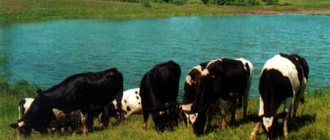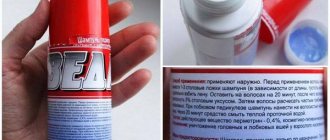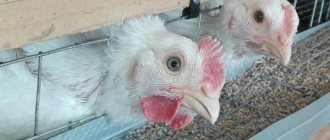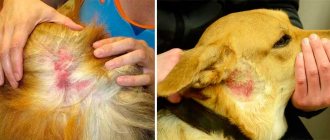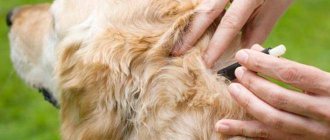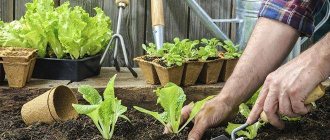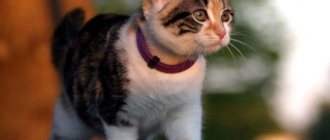Fresh meadow herbs are a natural source of nutrients and vitamins for cattle. When feeding animals with such food, their productivity increases significantly and their health improves. In addition, grazing cows on pasture is much more economical than constantly providing them with feed in stalls. But it should be remembered that grazing is most effective only if a number of conditions are met.
Fresh meadow herbs
How to choose a place for pasture
If we open any manual on cattle management and look at the table of contents, we will see that much attention is paid to pasture management. However, its organization is not as simple as it seems at first glance to a layman. Not every place is suitable for grazing cows. First of all, the pastures must be sufficiently abundant and grassy. If the grass is withered, short, and tough, then, of course, there will be no benefit from such food.
Secondly, the area where livestock will graze must be clean. In the spring, before releasing animals, the pasture is inspected, stones, brushwood, animal corpses and bones, rotten grass, garbage, and manure are removed. It is unacceptable for a cattle burial ground or other burial sites to be located next to a grazing meadow.
The pasture should not be too far from the farm, otherwise the cows will get very tired on the way. The best distance is 2-3 km.
The grazing place must be chosen so that there is a watering hole nearby. However, the water source must be safe, so a sample is taken from it in advance and examined in the laboratory.
To prevent the cow from injuring her legs or getting lost, choose a flat, easily visible area for grazing. It is necessary to have shelter from the sun - trees or a camp.
When is the first time to turn out cows in the spring?
When turning animals out to pasture in the spring, it is extremely important to wait until the optimal time. If you do this too early, the cows will trample down the roots of the plants, which means that the area will quickly exhaust itself, losing the ability to renew itself. If grazing starts late, the grass may already have grown a lot, which can lead to overeating and digestive problems for the animals.
It is best to start grazing cattle when the height of the vegetation reaches 15 cm. In this case, the transition should be carried out smoothly over the course of a week. First, in the morning and evening, the cow needs to be fed with hay, and the grazing time should be increased every day, starting from 2-3 hours. It is also advisable to place troughs with concentrates and mineral supplements on the pasture, which will help replenish the reserves of macro- and microelements, fiber and carbohydrates. Regular salt and compounds based on calcium and phosphorus are suitable as a top dressing.
What herbs should be like
Not only the quantity of grass is important, but also its quality. For cattle, cereals and legumes are best. Wetlands are dangerous because of poisonous greens and shellfish that carry helminths. Plants in such zones are poor in nutrients, which is why animals develop ailments caused by a lack of various micro- and macroelements. If there are wetlands in the pasture, they must be fenced off to prevent cows from going there.
Wooded areas are not suitable for grazing because animals may injure their legs or udders. In addition, there are many ticks and other harmful insects in the forest area. Not only will they disturb the livestock, but they can also infect them with dangerous diseases or parasites. In addition, there are few nutritious grasses here, and this has a bad effect on the productivity of dairy cows.
Classification of lands by purpose
Long before the advent of technology for cultivating land, grazing in rural settlements took place on pastures. For this purpose, the animals were collected into herds, which the owners drove out of the farm yards in the morning.
The shepherds gathered, grazed until sunset, and in the evening drove them to the gates of the house:
Typically, domestic cattle from collective farms or farms are grazed on separate lands. The grazing field may be cultivated or natural.
Cultivated arable lands are sown:
Lands differ by type:
To increase milk yield or increase the weight of meat varieties, with the onset of warmth, the herd grazes in the meadow around the clock.
When free grazing of livestock is not possible on pastures, due to mountainous or swampy terrain, the corral method of raising cows or sheep is used, which are kept in stalls, sheds, and outbuildings.
We provide the right watering place
Sources of water for cattle grazing may be different, but it is better not to use rainwater, as it has a poor mineral composition. However, if other options are not suitable, you can take it, but then the animals need to be given mineral supplements.
Artesian waters, which lie deep underground, on the contrary, have a rich composition. But sometimes they are oversaturated with salts and other substances. Cattle may refuse to drink such water or become even more thirsty.
If there is a river, pond or lake nearby, you need to make sure the water is safe. The place chosen for the watering hole must be fenced and a descent convenient for the cows must be made.
If there are no sources of water nearby, drinking bowls are made by digging wells in the ground. Every time after the cows drink, the water is changed so that bacteria do not multiply there. For the same reason, the soil around the drinker should not be allowed to “sour.”
Remember that the distance from the grazing area to the water should be no more than 2 km, so that the cow can walk back and forth without getting tired. Cows need to drink 3-4 times a day, in hot weather - up to 5 times. Water temperature is also important. In summer the optimal temperature is 16-20 degrees, in winter 8-12. For calves, the water temperature should always be 15-16 degrees.
Society
With the beginning of the grazing season in the regional center, for several years in a row, the problem of stray stray cattle has become acute. From spring to autumn, herds of goats, sheep, cows and even herds of horses walk freely along the streets of the village. They trample lawns, destroy flower beds, young green spaces, and wander into gardens and vegetable gardens, causing considerable damage to their owners. Often, stray homeless cattle create an emergency situation on the streets of the village and on the highway passing nearby, endangering not only their lives, but also the lives and health of people participating in the movement. Goats have been roaming in the regional center for a long time, since Soviet times. They were never grazed, although they should have been. But the outrages with sheep and cows began to happen three or four years ago. There were no more people willing to be hired as shepherds. The number of livestock decreased, and the income of shepherds decreased accordingly. It is also costly for livestock owners to increase their payments. They tried to organize alternate herding, as in the villages of the region. Did not work out. Previously, each microdistrict of the regional center and Starye Kaltasy had its own herd and its own shepherd. Last year, livestock grazing was already organized only in the northern microdistrict. But now the shepherd is gone there too. All for the same reason. Thus, if grazing is not organized, there will be even more stray cattle in the regional center. Deputies of the district and village councils, representatives of the veterinary service and the agriculture department of the district administration took part in the meeting in the administration of the Kaltasinsky rural settlement. After discussing all aspects of the problem, it was decided to hold meetings with livestock owners and invite them to purchase electric shepherds. Installing them on pastures can solve the problem. There is no other option. In neighboring areas this has long been practiced everywhere. Yes, and we have examples. In the small village of Yasnaya Polyana, Kaltasinsky rural settlement, cattle have been grazing behind the wire fence of an electric shepherd for several years now. And no problems. In order to force pet owners to pool together the necessary equipment and thus organize grazing of their livestock on pastures, deputy of the Municipal District Council Rinat Khaidarov proposed tightening the fight against stray cattle. Namely, drive them into a special room, charge owners for their care and, of course, fine them for improper care of animals. In a rural settlement, the rules for passage and grazing of livestock are determined. Violation of them already entails penalties. Now, at their next meeting, deputies of the Council of the Kaltasinsky rural settlement intend to make a decision, according to which the punishments for negligent livestock owners will be much tougher. And stray cattle isolated in a pen, if the owner does not show up within three days, can be sent to a meat processing plant. If it is numbered, it is not difficult to find it using the owner's identification number. These are the sanctions that await livestock owners in the event of homeless grazing of their animals. Therefore, it is better to chip in with your friends and buy equipment for an electric shepherd.
08.05.2019
We organize animal grazing correctly
The pasture housing system has its own rules. Thus, animals should not be grazed during frosts, after rain or in dew. This grass is harmful to the digestive system of cattle. This is especially true for wet grasses, which cows readily eat in the morning after a night break. A small portion is not dangerous, but a large portion will cause tympany - swelling of the rumen. This is a very unpleasant disease, fraught with complications. For the same reason, before spring grazing, they first wait until the ground and grass dry out, and only then release the herd.
During the summer heat, care must be taken to ensure that cows are in the shade during the heat of the day. Shelters are also needed in case of strong winds or rain.
When grazing, cows should be dispersed, not follow each other and not gather in groups, otherwise some of the animals will remain hungry. You also need to have a salt lick on the pasture (50 grams per day per cow).
It is important to consider the age and sex of the livestock. For grazing it is divided into groups:
- heifers, heifers over one year old, cows;
- calves from 2 to 6 months;
- calves from 6 to 12 months;
- feeding animals.
At the same time, the best areas are given to calves, highly productive, and also deep-pregnant cows. Bulls older than 12 months are kept separately from heifers, but there may be one male in the herd for every 50-60 cows.
Lots of water is important
The provision of water to grazing animals should not be underestimated as a factor influencing the amount of feed consumed by animals. Depending on the air temperature, a cow needs from 80 to 150 liters of water per day. Therefore, you need to monitor the availability of water in sufficient quantities, and large vats have proven themselves in practice (for large livestock - many vats).
A vehicle with a tank equipped with a single cup-shaped drinker, which can still be found on some farms, is absolutely not enough to optimally provide water for highly productive cows. The shortest path to the drinking bowl is also important, since animals are too lazy to go to drinking bowls that are located far away.
- Pasture remains, as before, a cheap main feed for cows
- Slow adaptation of animals with additional feeding of a diet suitable for pasture is mandatory.
- The use of concentrates should be limited, not least for economic reasons.
- For highly productive herds, half-day grazing with additional feeding in the barn is recommended, since in this way the animals can be provided with much better nutrients.
- The use of suitable mineral feed is necessary for optimal nutrition of cows.
- When grazing, water should not be neglected as an important factor for milk production.
Translation by Elena Babenko, especially for soft-agro.com
I look forward to your feedback and comments. Thank you very much!
Driving and distilling systems: what is the difference
The driven cattle keeping system is when the cattle spend the night on the farm and during the day go to a pasture 1.5-2 km away. Transhumance – when the pasture is located more than two kilometers away. Animals are usually delivered there by transport, and they stay there constantly. If cattle are driven to pasture, then watering points are placed along the way every 5-7 km and the animals are allowed to rest.
On distant pastures it is mandatory to have professional shepherds. If the grazing territory is located above three kilometers from the animals’ habitual zone, they will need adaptation. Cows are not driven to such pastures immediately, but after first being kept at a lower elevation.
Camps are often set up on transhumance pastures created for cattle. They are located in the center of the grazing area, providing a convenient route for bringing feed and livestock.
Selection rules
In order to choose a good device that will last more than one season, you need to pay attention to the following parameters:
- Method of nutrition. This can be an electrical network, a battery or solar panels. You need to choose a feeding method based on the characteristics of the pasture. A profitable option is a symbiosis of a battery with solar panels.
- Features of the herd. What animals are present in the herd directly influences the choice of power. Medium voltage will be optimal for a mixed herd with small animals (sheep, goats, and young cattle). If these are adult cattle, then you will need a powerful device.
- The density of vegetation in the pasture. As the manufacturers mention, the current strength can be significantly reduced if the live wire comes into contact with the grass.
- For permanent pastures it is much easier to choose a device, since you can buy a permanent type device. Such electric shepherds are massive, but cover a large area, and their mobility is low.
Why is driven grazing better than free grazing?
With the paddock system, all pastures are divided into plots that are used alternately. The advantages of this method are that the herd is easier to control and it is easier to separate animals into groups. If you use an electric fence, you can even do without a shepherd - not a single animal will run away.
When forming pens, the area is fenced with wire stretched over poles. Better reinforced concrete posts, or wooden ones made of hardwood, with a cross-section of 15x15 cm. Length - 200-220 cm, they are buried 50-80 cm. The posts are placed at least 80 m apart from each other. The area of the enclosure should be 20-25 hectares, They produce 100-120 cows. In one area, grazing lasts 3-6 days, no longer.
With free grazing, cattle go where they want, eating the best grass. As a result, weeds and poisonous plants begin to dominate the land. Over time, the territory becomes unsuitable for grazing. In a corral system, cows are moved from one area to another, giving the forage grass time to recover. This prevents the pasture from degenerating.
Advantages and Disadvantages of the Stall-Pasture System
Stall-pasture housing of cows does not require large expenses, so it is often used in small and medium-sized enterprises, as well as in peasant farms.
Among the advantages are the reduced need for space and the cost of the resulting products, the possibility of preventive measures directly during grazing, compactness, and the absence of costs for transportation and distillation of the herd.
The disadvantages of such a system are obvious: only a certain number of cows can be kept in a limited area; intensive trampling of grass occurs, especially in wet weather.
However, exercise has a good effect on animals in any case. Thus, a calf born by a cow that spends enough time grazing has better immunity compared to young cows that are “stay-at-home” cows.
What does Lean mean?
If you do not treat pastures with care, this negatively affects the vegetation and soil cover, water regime, microclimate, and the state of fauna and flora.
Animals eat grass unevenly. Valuable species may disappear, and more resistant, low-growing weeds will grow. What the improper use of pastures leads to is the deterioration of the quality of the grass stand with microbiological activity. The reason is excessive soil density and disturbances in the water-air regime.
In order not to begin to restore destroyed fields with forbs, it is necessary to follow preventive measures:
Such measures will protect:
Harmful insects will actively multiply on land knocked down by livestock. The shepherd must alternate the use of arable land - one year as hayfields, the next let the cattle graze in the meadow.
Rational grazing will ensure the predominance of valuable plants in the grassland.
Features of stall-walking housing
A free-range housing system is when animals are taken out for a walk in the pen after morning milking. Cows spend 3-4 hours in the pen according to plan, but in reality it turns out to be less. The fact is that a lot of time is spent untying the cattle, bringing them out, corralling them and tying them up. This is the main disadvantage of such a system. In addition, in practice, pens are often small in size and are cleaned too rarely. This creates a risk of disease occurring in the herd.
In addition, such a walk is not enough for the animals; they do not receive the required amount of sunlight. This has a bad effect on the health and productivity of the livestock.
However, the stall and range system is convenient for both small and large enterprises that have a lack of grazing space. With proper organization, the shortcomings of the system can be minimized.
Where to put the manure
The consequences of throwing out fresh manure for soil and water are serious and threaten environmental disasters. Unfavorable situations arise due to violations of the storage technology of this organic fertilizer. For example, there is contamination of groundwater with nitrogen compounds.
Due to the widespread nature of the phenomenon, the Law “On Manure” has been in force in Russia since 2014. These wastes are divided into hazard classes, so processing, transportation and disposal require certification. Documentation is expensive, and the profitability of an official enterprise that has organized storage methods according to recycling rules is reduced to zero. Private individual entrepreneurs and LLCs, under pain of fines, organize:
- Processing into vermicompost;
- Processing into biogas;
- Granulation.
The first option for processing manure is traditional. Farm waste is placed more densely in heaps. After 2-3 months, humus is obtained. It is harmless to plants and is as easily digestible as possible. Fertilizer is valued by gardeners and gardeners. The humus delivery business is considered a profitable, but seasonal phenomenon.
The second method is innovation, for which special designs are used. In them, the product undergoes anaerobic digestion. The installations produce energy fuel, which is used on farms to heat barns. Using the same generators, processed products are granulated, enriched with bacteria and used as high-quality fertilizers.
Grazing a cow on a leash, tethered housing
In farms where they practice tethered livestock keeping, each cow lives in a separate stall on a tether. The advantage is that an individual approach to animals is provided. However, during the grazing period, keeping cows takes a lot of time and effort. Each animal must be untied, brought to its place, then driven back and tied again.
During the cold season, cows walk on areas adjacent to the stalls.
If you have one or two cows, but there is no way to give them to a herd that regularly grazes, it doesn’t matter. You can organize individual grazing.
Choose a site that is level and has good grass, and drive a peg in the middle. One end of a long rope (6-7 m minimum) is tied to it, and a loop needs to be made on the second. The noose is placed around the cow's neck, but it should not strangle the animal. The cow is moved as it eats the grass in the area.
If there is no space for grazing at all, the cow still needs to be taken outside. Keeping her on such a leash, you can bring her food and water. This way she will eat and get healthy in the fresh air.
Milk storage
Despite the fact that raw materials are sent from farms to factories, they are also processed on site. All correctly performed operations at the initial stage will contribute to the preservation of the original properties of the product. Immediately on the farm, the milk produced is weighed. Then it is decanted through filters made of non-woven fabric or cotton wool.
Flannel or waffle fabric will eliminate mechanical impurities in the product. The rules for preserving milk require changing filters over each flask or bucket. Afterwards, they are immediately rinsed with running water. After finishing work, the fabrics are washed in a 5% solution of washing powder. The filters are then boiled and dried.
Centrifugal cleaners are better than filters at removing dirt from milk. In industry, it is customary to cool purified raw materials. The product can only be stored refrigerated, up to 4-6 degrees.
Important
The faster the temperature of the raw material decreases, the better its quality will be. Unrefrigerated milk is a good environment for harmful microflora. However, even a cold product, if it is not pasteurized, can only be stored for 72 hours. For longer preservation, heat treatment is important. Its goal is to reliably suppress harmful microbes.
There are several types of processing - pasteurization, sterilization, thermization. The first effect is related to temperature (its increase) and duration. There is short-term - 20 seconds, 75 degrees, long-term - 30 minutes, 60 degrees, instant - without exposure, 98 degrees.
The choice of mode is related to the properties of the product (quality, veterinary certificates, appearance, smell).
Unpasteurized milk cannot be sold in grocery stores. According to regulations, only products that have undergone heat treatment can be on the shelves.
